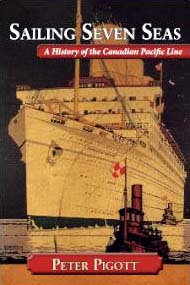
30 January 2011
Tale of CP's Shipping History
Riddled with Errors

Victoria Vancouver Island British Columbia - "Sailing Seven Seas: A History of the
Canadian Pacific Line" by Peter Pigott, Dundurn, 228 pages, $35.
Canadian Pacific helped shape Western Canada through its railway, its ships, its hotels, and its airline. The corporate history is so intertwined with the
history of the West that it be hard to imagine one without the other.
It's also hard to imagine that a book such as Peter Pigott's Sailing Seven Seas could fail so miserably given the rich material available, and the amount
written so far. Accuracy matters, and this book falls spectacularly short.
This is one of the worst Canadian history books of this century. Really. It's that bad.
Consider, for example, the driving of the Last Spike, the ceremony that marked the completion of the railway that linked British Columbia to the east. The
photograph of the last spike is one of the most famous in Canadian history, and the location of the ceremony is no secret: It's Craigellachie.
 That's not what Pigott says. The last spike, he writes, was driven at Salmon Arm. In his next sentence, he contradicts himself, saying that the station where
the spike went in was named Craigellachie after all. But it's too late, the damage is done.
That's not what Pigott says. The last spike, he writes, was driven at Salmon Arm. In his next sentence, he contradicts himself, saying that the station where
the spike went in was named Craigellachie after all. But it's too late, the damage is done.
After 125 years, surely there is no reason for uncertainty about Craigellachie. Or, put another way, if someone says Canadian Pacific's Last Spike was anywhere
other that Craigellachie, proceed with caution. If an author misses his mark by 50 kilometres, you need to doubt everything else he says.
Flash forward to the Second World War, when the Children's Overseas Reception Board was sending British children to Canada.
Pigott says that one of the vessels carrying children, City of Benares, was torpedoed on 17 Sep 1941. It was really 1940. A minor point, maybe, but wait,
there's more.
He says a ship called Voledam was torpedoed on 28 Aug 1941. In truth, it was 1940. And it was August 30. And the ship's name was Volendam.
Volendam has been one of the most famous names in the Holland America line for almost a century. How could anyone get it wrong?
A few pages later, we find this line: "On 1 Oct 1962, the Canadian Pacific left the British Columbia ferry and coastal steamship business
forever."
So clear. So definite. So wrong. Where is his evidence?
CP reduced its passenger service in 1962, but did not kill it. The company maintained a passenger ferry between Vancouver and Nanaimo for another couple of
decades, and had service to Swartz Bay as well.
Perhaps Pigott did not get a chance to ride on the CP ferry in the 1970s, as many of us did. Perhaps he was not able to check the microfilmed newspapers from
Victoria, Nanaimo, and Vancouver, they would have helped him get his facts in order.
Surely, however, he could have checked Robert D. Turner's "The Pacific Princesses", which would have set him straight. The Turner book is in Pigott's
bibliography, so we might assume that he was aware of it.
He could also have read "The Princess Story" by Norman R. Hacking and W. Kaye Lamb. The truth is out there, it's just not to be found in "Sailing
Seven Seas".
It could be that these are the only errors, and that the rest of the book is accurate. But really, what does it matter? When so many basic facts are wrong, can
we trust anything in "Sailing Seven Seas"?
Dave Obee.

|